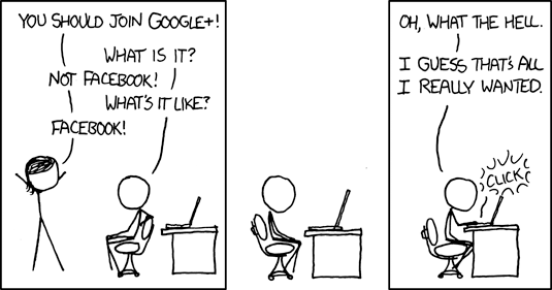An open source project that helps one collect one’s personal data, from the web (will need API keys), and store it locally.
locker demo on youtube source on github
via
Tag: internet
baseball coming to the uk
baseball bats, anyway. sale of bats is up 52,000% in 24 hours. amazon.co.uk

xkcd on google+

kind of screwed – waxy.org
Andy Baio cited the Jeff Koons case, in regards to his trouble with Kind of Bloop
This kind of transformation is the foundation of fair use. In a 2006 verdict, the court found artist Jeff Koons’ use of a fashion photo “adds something new, with a further purpose or different character, altering the first with new expression, meaning, or message.”
I don’t think there’s any question that Kind of Bloop’s cover illustration does the same thing. Maisel disagreed.
I think Maisel’s lawyers would cite Cariou vs. Prince. There are questions, and they are kind of valid.
I would have recommend the circled ones; compositionally less dependent on the source image.
untitled
TS – paradise
Thomas Struth
Paradise 2
signed on a label affixed to the reverse
cibachrome print
image: 177 by 226cm.; 69 3/4 by 89in.
sheet: 183 by 231cm.; 72 by 91in.
Executed in 1998, this work is number 4 from an edition of 10.LITERATURE
Ingo Hartman & Hans Rudolf Reust, Thomas Struth: New Pictures from Paradise, Munich
2002, no. 7301, illustration of another example in colour
Uta Grosenick, Ahead of the 21st Century: The Pisces Collection, Cologne 2002, pp. 168-169, no.
130, illustration of another example in colour
artwork and “participant”
Lygia Clark
0.0
industrial paint on wood
41 by 82cm.; 16 1/8 by 32 1/4 in.
Executed in 1957-1982.AUTHENTICATION
This work is registered in the archives of The World of Lygia Clark Cultural Association under
number 544 and is accompanied by a certificate of authenticity.
CATALOGUE NOTE
Lygia Clark was one of the most innovative Latin American artists of the 20th Century. She
transformed the practice of geometric abstraction through a profound belief in the importance of
interaction between an artwork and “participant”.
Clark initially explored the Modernist traditions that infiltrated Brazilian culture in the 1940s, and
looked toward geometric abstractions and the interplay of colour and line in the construction of
pictorial space. These initial investigations soon developed into bolder, more dynamic
compositions. The artist’s pivotal role in the Rio de Janeiro-based Neo-Concrete movement in the
late 1950s was imperative to her artistic development. The group challenged rationalist
Constructivism and promoted a subjective, more organic approach to art. The use of new
materials was greatly encouraged, as was the importance of invention and creativity.
Conceived in 1957 and realised in 1982, Superfície Modulada No. 2 is a beautifully serene
example from this incredibly important transitional period. Clark’s use of industrial paint on wood
together with her method of penetrating the picture surface with linear divisions, underscores her
interest in physical versus pictorial space. By fracturing the surface of the painting with fine
recessed lines, Clark creates something tangible, almost three-dimensional, thus disallowing a
planar reading of the surface. The absence of a frame or visible support allows the artwork into
real space within which the viewer can exist. Lygia Clark would endeavour throughout her career
to create a more direct relationship between the body and the object itself. With Superfície
Modulada No. 2, Clark creates an alternative for the art object. With this early and seminal work,
we see the beginning of the artist’s conception of art as an immersive and subjective experience.
via sothebys
Groklaw – SCEA vs.Hotz
Groklaw – Hotz Ably Fights for His Motion to Dismiss – Tells Court SCEA’s Case Doesn’t Belong in CA.
I am starting to follow this case. very dramatic; a bit more interesting than Cariou vs. Prince.
Hotz’s Reply to a SCEA motion
The message that Sony Computer Entertainment America (“SCEA”) is conveying to George Hotz (“Mr. Hotz”) and the public is of great consequence. SCEA advocates and encourages the Court to accept that simply by connecting to the Internet, you are consenting to jurisdiction anywhere in the world. SCEA has taken advantage of these unfamiliar concepts in order to present the Court with misleading sets of facts and affidavits.
Mr. Hotz is a 21-year-old individual who resides in New Jersey. He is not a multinational company, or even a company at all–he is just one person. He did not profit from his actions in question and he did not sell any circumvention devices. He is however, known for being a prodigy in the computer programming field. Mr. Hotz’s actions which gave rise to the controversy are simple: (1) Mr. Hotz published code he independent created (“Code”)(2) Mr. Hotz used the Code on his Playstation Computer, and (3) Mr. Hotz posted his findings on his personal blog.
SCEA filed this action, claiming jurisdiction over Mr. Hotz is proper in California. SCEA then flooded the docket with affidavits from its lawyers and employees, offering ambiguous and misleading information. SCEA then indicated that it would undoubtedly confirm that jurisdiction in California is proper for Mr. Hotz through jurisdictional discovery. Now, after Mr. Hotz’s computer hard drives, and a graphing calculator have been impounded, and Mr. Hotz’ discovery responses have been timely submitted, SCEA still is unable to present evidence to refute the jurisdictional challenges asserted by Mr. Hotz. Instead, SCEA has only continued to flood the docket with dubious information, such as irrelevant hearsay blog postings filed under seal, and misleading affidavits from enigmatic employees with no explanations of the source of their personal knowledge.



